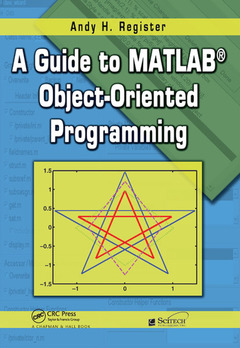A Guide to MATLAB Object-Oriented Programming
Auteur : Register Andy H.

A Guide to MATLAB Object-Oriented Programming is the first book to deliver broad coverage of the documented and undocumented object-oriented features of MATLAB>. Unlike the typical approach of other resources, this guide explains why each feature is important, demonstrates how each feature is used, and promotes an understanding of the interactions between features.
Assuming an intermediate level of MATLAB programming knowledge, the book not only concentrates on MATLAB coding techniques but also discusses topics critical to general software development. It introduces fundamentals first before integrating these concepts into example applications. In the first section, the book discusses eight basic functions: constructor, subsref, subsasgn, display, struct, fieldnames, get, and set. Building on the previous section, it explores inheritance topics and presents the Class Wizard, a powerful MATLAB class generation tool. The final section delves into advanced strategies, including containers, static variables, and function fronts.
With more than 20 years of experience designing and implementing object-oriented software, the expert author has developed an accessible and comprehensive book that aids readers in creating effective object-oriented software using MATLAB.
Date de parution : 08-2017
17.8x25.4 cm
Date de parution : 05-2007
Ouvrage de 354 p.
17.8x25.4 cm
Thèmes d’A Guide to MATLAB Object-Oriented Programming :
Mots-clés :
MATLAB Object Orient Program; Code Listing; MATLAB; Test Drive; object-oriented programming; Private Member Variables; software; Public Member Variable; group of eight; Member Variables; Andy H; Register; cShape Object; simple container class; Class Wizard; singleton objects; Member Functions; Private Variables; Switch Index; RGB Color; Public Variables; Double Array; Public Member Function; Parent Child Inheritance; Object Oriented Programming; MATLAB Object Orient; Cell Array; Function Handle; Helper Functions; Handle Graphics; RGB; Operator Syntax; Case Code



